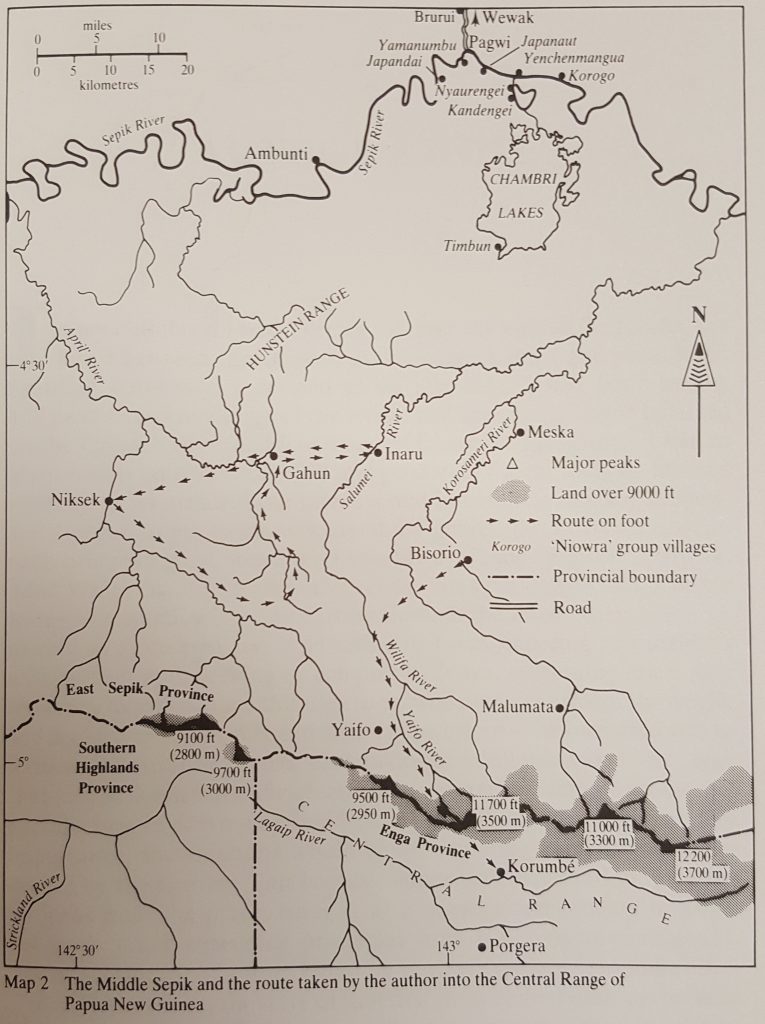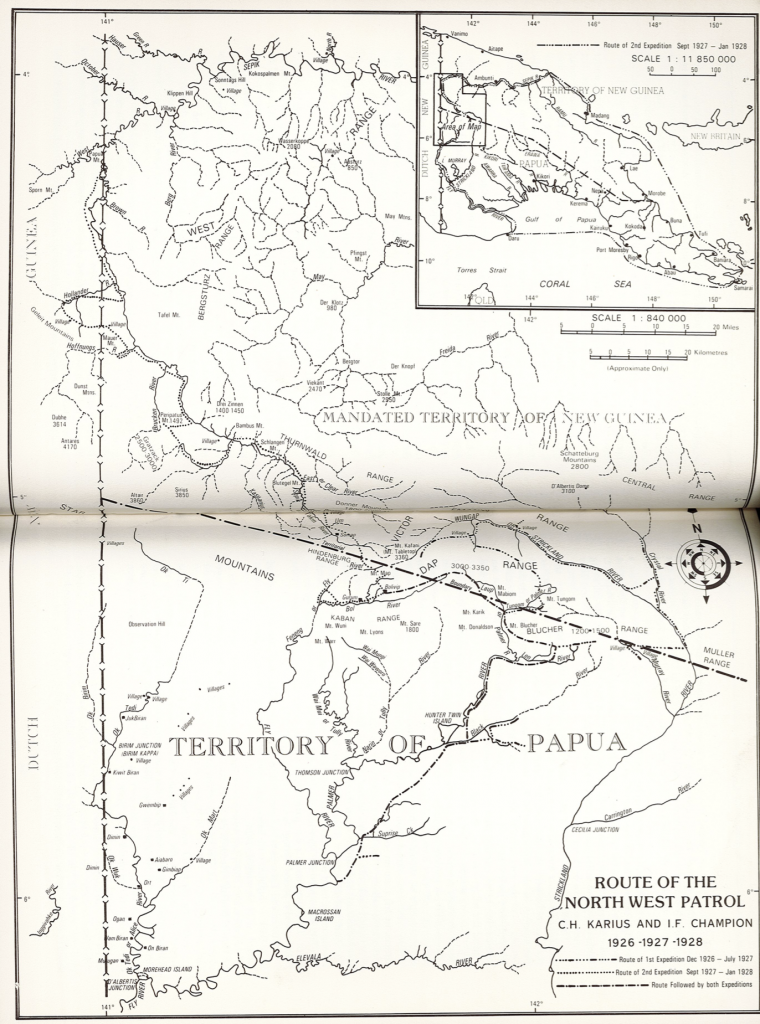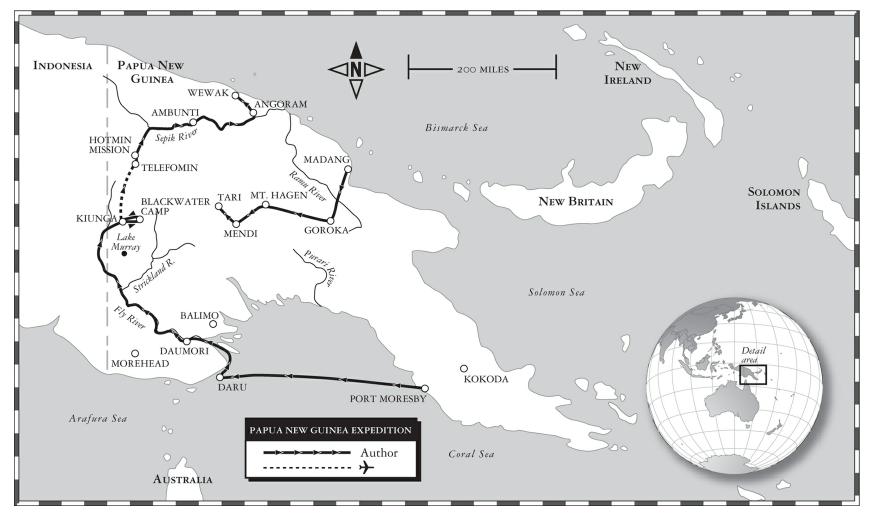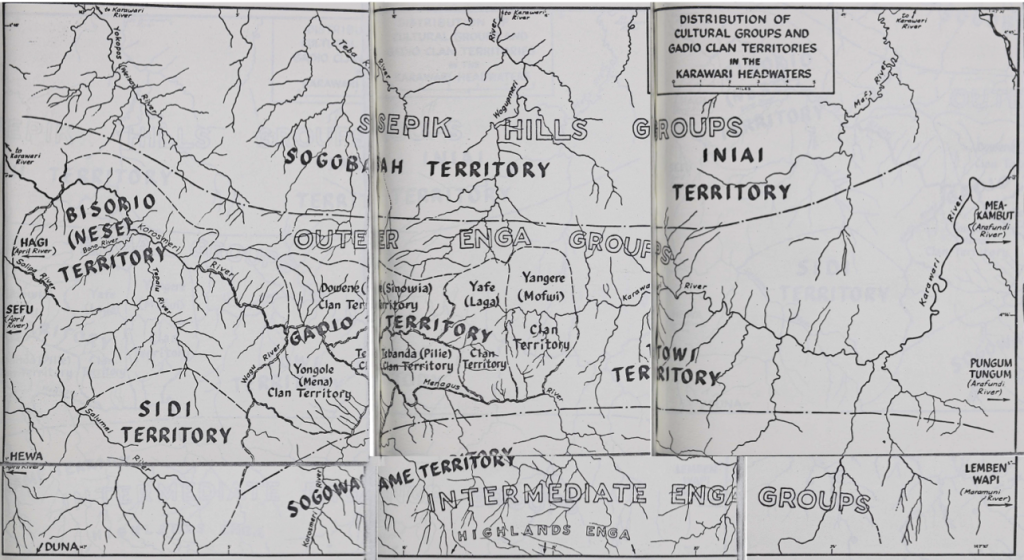British “explorer” Benedict Allen made news recently by being rescued from a failed attempt to cross the central mountain range of Papua New Guinea and paddle downs stream to the coast. While most of the world was alternately amused and thrilled to hear of Allen’s failed exploits, those of us who have lived in Papua New Guinea were struck by Allen’s invocation of uncontacted tribes and primordial jungles. To be honest, this sort of thing does more to convince me that it is Allen, not Papua New Guineans, who is out of touch with the modern world. Others have claimed that Allen’s failed walk is rooted in racism and bad for the Papua New Guineans who hosted him. As a historian and anthropologist who lived for two years in Porgera (about 20 miles from where Allen was eventually rescued) I want to weigh in here with another criticism of Allen: Although he claims to be be the first person to cross Papua New Guinea’s central ranges, he is not. His accounts of his amazing feats not only downplay the achievements of Papua New Guineans, they ignore — or perhaps were made in ignorance of — the actual explorers, both white and Papua New Guinean, who have so long ago accomplished what he claims to have done first.
This most recent failed walk repeats a path he took in the late 1980s, which he describes in his book The Proving Grounds. In it, he is flown into the upper reaches of the Sepik, crosses the central ranges, and then ends up on the shores of the Lagaip, and then returns to Port Moresby, the capital of Papua New Guinea. It’s hard to judge, but I reckon the total distance is about 50 kilometers as the crow flies. But that doesn’t really give you a sense of how onerous this walk is. On his website Allen claims that this walk was “the first recorded crossing of the Central Mountain Ranges of PNG”. This is incredibly tough terrain, and he should be congratulated for managing to do it. But he was not the first. Not by a longshot.

Ironically enough, Allen’s ill-fated trip to PNG happened in 2017, which is the 90th anniversary of the actual first white people who crossed Papua New Guinea: Ivan Champion and Charles Karius. Champion and Karius were patrol officers sent by the Australian administration of Papua to explore and map the island. Their epic patrol — which took over a year — involved dozens of people, including Papua New Guinean porters and police men who should be recognized (as Champion and Karius did) as key to the patrol’s success. Rather than getting dropped in the middle of the island as Allen was, Karius and Champion went up the Fly river, crossed the central ranges, located the headwaters of the Sepik river, and then went down it. It’s difficult to describe how difficult this patrol was, especially in 1927, before the advent of GPS or modern synthetic fabrics. Benedict Allen didn’t take a map because of some personal code of honor or something. Karius and Champion didn’t take one because there wasn’t one. And they went to make one. The patrol is described both in Champion’s book Across New Guinea from The Fly to The Sepik and in Champion’s biography of Champion, Last Frontiers”.

There is also an example of people crossing in the direction that Allen came: From the northern side of the island. During World War II Catholic missionaries, priests, and nuns lived at mission stations up and down the Sepik. When the Japanese invaded, many of them moved upland, into the Sepik headwaters, in order to escape. Several of them, accompanied by the Australian patrol officer James Searson, ascended up into the central ranges, where they were met by the Australian gold miner and plantation owner Dan Leahy. After meeting in Maramuni, Leahy, Searson, and the Catholics ascended the central ranges and then walked down the high valleys in this area, rather than taking sailing down to the south coast. The journey was an incredible feat of endurance. The elderly nuns on that patrol did what Benedict Allen could not: cross the central range and then walk to a town. The walk had its price: Dan Leahy suffered hearing and vision loss for the rest of his life as a result of this trip. This walk is documented both in Fowke’s biography of Leahy, Kundi Dan, and in Theo Aerts’s The Martyrs of Papua New Guinea. Unfortunately, there’s no map of the patrol for me to show here. But trust me: It was a big walk.
Others, like Allen, started in the center and then worked their way out, but headed north. Jim Taylor, another government officer, undertook a massive patrol in 1938 and 1939 in which he walked from Mt. Hagen, in the center of the country, over the central ranges, and down the Sepik in canoes. This patrol was amazing for the stamina and endurance of both Taylor and his number two, John Black. Bill Gammage’s book The Sky Travellers describes this patrol in meticulous detail, and includes the perspectives of the indigenous police and carriers who were on the patrol, as well as the viewpoints of the people who they met along the way. It’s probably my favorite book ever written on Papua New Guinea. Having read it, I can say with conviction the Benedict Allen is no Jim Taylor.

Benedict has also been bested by at least one other travel writer. Kira Salak’s Four Corners is an account of her recreation of Champion and Karius’s 1927-19 28 patrol. In this book she recounts her (successful) journey up the Fly and down the Sepik. She completed her trip in the period between Allen’s two attempts. To be fair, she did get a lift from Kiunga to Telefomin from OTML, the mining company active there. I prefer her book and her subsequent novel about PNG, White Mary, to Allen’s work.

Colonialism in Papua New Guinea can and should be criticized. But it was different in form and intensity than that in other areas of the world, especially before World War II. There was, as Edward Lipuma once put it, no Australian Pizarro in Papua New Guinea. These early patrols were exercises in natural history and cartography, and the explorers had strict orders not to shoot, which they did their best to obey. The patrols were chances for the Papua New Guineans they encountered to hold of things like salt and metal, which they needed. Police and carriers were central to the patrol’s success, and their lives and contribution to the nation were documented in works such as August Kituai’s My Gun My Brother . They helped strengthen the connections between Papua New Guineans and wider world, connections that have continued to grow in strength today.
Australian colonialism in Papua New Guinea was far from perfect, but by global standards it was not bad — although I recognize in saying that I’m setting the bar pretty low. My point here is simply this: Compared to the actual explorers who came before him, Benedict Allen’s walk is small beer. Even by his own, Boy’s Own Adventures standard, he pales in comparison to great patrol officers such as Hides, Taylor, Searson, Champion, and others.
It’s also striking to note just how little Allen learned about PNG when compared to anthropologists who have done fieldwork in this extremely remote location. Take a look at Proving Grounds and then look at Mark Dornstreich’s remarkable 1973 thesis on this same area. Here is a map that Dornstreich published in the thesis showing ethnic groups in the area:

I promise you: This was not easy fieldwork. Unlike Allen, he took his family to the field. His son remembers “Once, my father walked for three days to get to the nearest vehicle, so he could drive to get medicine for my mom’s malaria.” Best of all Dornstreich went on to have a remarkable 30 year career as a farmer pioneering the local and organic food movement. Now that’s a story.
I could go on: About indigenous trade routes in Papua New Guinea, about the guides and hosts who so graciously offered their hospitality to Allen when he was lost and ill, and so forth. But I hope the point is made: Allen’s writings not only diminish the accomplishments of Papua New Guineans, they diminish the accomplishment of other white explorers! And this despite the fact that so many of those explorers accomplished so much more than he did. You don’t need to be some sort of rabid professor obsessed with political correctness to realize the limits of Benedict Allen’s brand of “exploration”.
And for those who wish to delve deeper into the (many) accounts of 20th c. encounters between local Papuans and New Guineans and outsider explorers, I recommend the book “Like People You See in a Dream: First Contact in Six Papuan Societies,” by Edward Schieffelin and Robert Crittendon (1991). A fascinating account of the 1934-35 Strickland-Purari patrol, with good follow-up accounts of interviews with local people many years later.
I enjoyed your essay, Alex. I am left with a question: To what extent do travel accounts like Allen’s really benefit from the claim that they are the first to go to a particular place or take a particular path? As you point out, foot travel in this region is tough and the locale and people are fascinating – all of which provide plenty of material for an interesting story. It is as if the genre of unusual-location travel is so restrictive that it compels the authors to strap on a pith helmet and focus on the inevitable foot fungus/malaria/large insect accounts, and the “never done before” elements, that are the stock contents of this kind of writing.
“Allen claims that this walk was “the first recorded crossing of the Central Mountain Ranges of PNG”. ” I think he means the first to be recorded on an iPhone X.
Karl Rambo’s comment prompts at least three minor observations. First, earlier generations of anthropologists, especially grad students, engaged almost ritually in the post-fieldwork swapping of research horror stories, in a friendly competition to see who had it worst. This seems to have declined somewhat as our grad students increasingly work in Western settings without the malaria and foot fungus, but the point is that this kind of writing has at least one analogue in informal fieldwork stories. Sometimes this could be comical. I remember one evening years ago when several of us post-fieldwork dissertators were sitting in Jimmy’s, comparing such stories, and a fellow student who had worked in New Guinea said “I’ve got you all beat: I had to walk 6 hours to get beer!” Of course, the student who had recently returned from Amazonia commented quietly that he would have had to canoe several days down-river to find beer….
Second, the genre might be related to the heroic quest tales we’ve been reading at least since Gilgamesh — the hero encounters with all manner of demons, monsters, and puzzles (not to mention malaria and foot fungus and large insects) and overcomes them to return as an ennobled figure. Here again, the genre may be much, much wider than travel accounts.
Third, Karl (and anyone else) might be interested in the remarkable book by A. David Napier, “The Age of Immunology: Conceiving a Future in an Alienating World” in which he draws a interesting parallel between the medical model of immunology — contact with a ‘foreign’ body provokes a change in a host that incorporates features of it to prevent that host from reacting badly to any future contact — and fieldwork — contact with a foreign culture provokes changes in an anthropologist, etc. etc. Napier’s book is brilliant beyond my ability to summarize it easily, but it is organized around such themes as they ramify outward to every dimension of life. Try it.